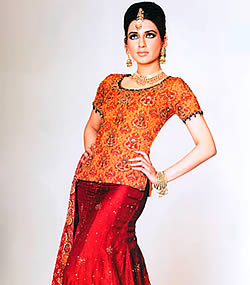|
Lengha choli, (Langa or Lehnga) are obtainable for women of all
dimensiona. Lengha Cholis have a gorgeous history in India. When
the Moguls invaded India in early on BC they brought this
inimitable skirt and blouse combination with them. Today's bride
is more likely to be dressed in a Lengha Choli to her wedding
than a sari due to the heavy weight of bridal saris. Women of
all ages also feel affection for Lenghas for formal events and
dress occasions. Women just can not go erroneous with a fashion
item that has been in fashion for hundred of years.
Tremendously beautiful and appropriate to all female shapes,
Lenghas are frequently hand decorated in the conventional
designs of India such as zardozi embroidery. Throughout the era
of Indian royalty, these Lehnga designs became legendary and
were made with genuine gold, silver and precious stones. Just as
in ancient times, these Lehnga suits are still hand decorated to
stay it as true to custom as possible.
Throughout initial times, the lehnga was just a piece of fabric
tied around the waist with the ends of the cloth left loose. The
fabric was held at the waist with a metal strap. But soon with
the increase in its attractiveness, the lehnga went from side to
side a variety of transitions to suit the convenience of the
women. The ends of the waist fabric were stitched. To make it
more relaxed, its narrow width was increased by bring in more
pleats on the waist, so as to make it trouble-free to walk for
the women. The metal girdle was replaced by stitching a piece of
cloth to the waist of the lehngas called nepaha and a piece of
rope running through is called nara.
The lehnga reached its climax of growth under the Mughal kings.
It was the finest answer the Indian queens could provide to the
rich Muslim pehsvaz dress of the Mughal royal women. The
communication between the two communities was additional
increased by the bazars organized by the Mughal kings where both
the sellers and the buyers were women. The dupatta (the
Hindustani name specified to the orhani by the Indian Muslim
women) became approximately a mark of respect for the women. It
was frequently two and a half yards in length and one and a half
yards in breadth. It was used as a headdress and also to
increase the loveliness of the lehnga. Frequently the dupatta
was made of a slight material and to give some additional weight
to the cloth, golden lace or tassels were attached to the ends.
The choli was also developed the wrap the arms but the length,
however, generally remained above the navel, revealing the slim
waist of the women. The fabrics used to make the lehnga are in
fact the identical as those used under the great Mughal King,
Akbar; silks and brocades. The dupatta is now made of silk,
linen of chiffon which is a new development.
The fame of lehngas has wrinkled proportionately with the
period. In fact, in northern India it has very productively
replaced the conventional sari as a wedding dress. Now Indian
brides favor to wear lehngas which enhance their loveliness and
charm. The dress is mostly made in red which represents
enthusiasm and passion; orange which is a blend of yellow and
red; colors so opposing in character– produces mystical effects
on the mind; pink possesses all the powers and brightness of red
without its frenzied impulsiveness and violence. The
attractiveness of this royal dress however lies in the very well
embroidery or zari handwork done on it. This zari skill done on
the lehnga is of a very particular quality and is done
frequently by Muslims staying in the 100 odd villages of
Farokabad in Uttar Pradesh and Lucknow.
The lehnga is hence a masterwork of all these forms of
embroideries in a variety of combinations. Hence we can say the
lehnga is one element of history which at rest lives on in India
and Pakistan. In Pakistan, it is largely used as wedding or
party wear.
Copyright © TheHeer.com. All Rights Reserved.
Privacy Policy |
Franchise Oppertunity
|



